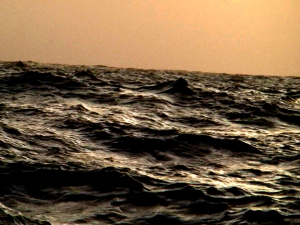Ocea
Ocea, 2009
COUNTRY OF PRODUCTION: North Atlantic
LENGTH: 3 min 18 sec
Editions: 10
In einem ethnologischen Museum fiel mir ein handflächengroßes leichtes Gebilde, eine Gitterkonstruktion aus gebogenen und geraden Bambusstäbchen auf. Diese waren an allen Überschneidungspunkten mit Bast zusammen gebunden und einige gebogene Stäbe durchquerten die Konstruktion ganz. Es war ganz offensichtlich kein Zierrat, zu unregelmäßig waren die Anordnung und die Form, im Außenumriss ein unregelmäßiges 5-Eck.
Inmitten des Ozeans bewegen sich Wind Wellen und mit dem Schiff der Standpunkt des Betrachters in einer unaufhörlichen Veränderung und Bewegung zueinander, da ist nichts woran man sich orientieren könnte. Aus einer Kamera besehen driftet dabei die Wellenlandschaft in einer auf ihn zentrierten Perspektive am Betrachter vorüber, immer wieder anders und unendlich, zugleich ewig und monoton. Einzig sein Blicken macht den Betrachter selbst zum trügerischen Fixpunkt.
In dieser Montage einer Videosequenz nun sind die Einzelbilder so auf einem schwarzen Grund angeordnet, dass statt dem Betrachter das Motiv ins Zentrum gerückt und vom Auge der Kamera umkreist wird. Kleine Abweichungen von einem zum nächsten Bild erzeugen in ihrer Abfolge eine räumliche Drehbewegung, wodurch im Betrachter der Eindruck einer virtuellen Tiefenräumlichkeit im zeitlichen Nacheinander entsteht.
Solche Bambusgebilde waren Seekarten. Durch Beobachtung von Strömungen und ihren Überschneidungen die sie aus den Wellen des Ozeans herauslesen konnten, hatten polynesische Seeleute eine Orientierung entwickelt, mit der sie sich in die Weite des Pazifiks hinaus wagten.
//
In an ethnological museum, I noticed a light, palm-sized shape, a grid construction from curved and straight bamboo sticks. At all points of intersection, these were bound together with bast; some of the curved sticks ran across the construction as a whole. This was clearly not an object for decoration; arrangement and form seemed too irregular, the outside contour an irregular pentagon.
In the midst of the ocean, wind, waves and – boat-bound – the standpoint of the observer, shift in continuous change in relation to one another, without any points of orientation. Seen from a camera, the landscape of waves drifts past the observer from a perspective centred on him, always changing but infinite, eternal and monotonous. It is only his staring which fallaciously seems to make the observer himself a fixed point.
In this montage of a video sequence, the single images are arranged on black ground in a way which positions the motif, not the observer, in the centre, circled by the eye of the camera. Minor discrepancies from one image to the next produce, in their sequencing, a sense of spatial rotation. The observer has the impression of a virtual spatiality of depth in the temporal succession.
These kinds of bamboo constructs were used as sea charts. Through the observation of currents and their overlaps, readable from the ocean’s waves, Polynesian seamen had developed a system of orientation by means of which they dared to travel into the depths of the Pacific Ocean.
What happens when I click "Inquire"?
When you click “Inquire,” you send an e-mail to epodium gallery to express your interest and we will follow up with you to answer any questions, confirm pricing and availability, if you're ready to go ahead with a purchase. We are also happy to provide contextual materials about the artist.

